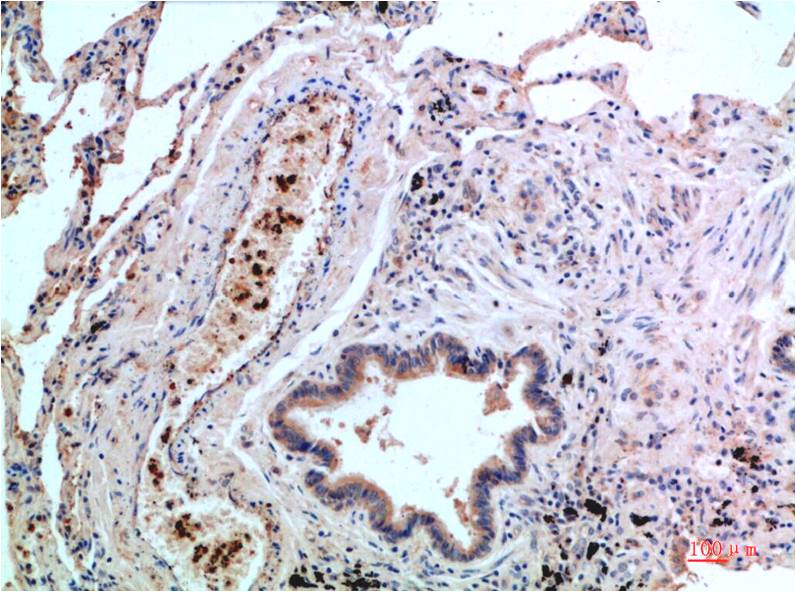
| WB | 咨询技术 | Human,Mouse,Rat |
| IF | 咨询技术 | Human,Mouse,Rat |
| IHC | 1/50-1/100 | Human,Mouse,Rat |
| ICC | 技术咨询 | Human,Mouse,Rat |
| FCM | 咨询技术 | Human,Mouse,Rat |
| Elisa | 咨询技术 | Human,Mouse,Rat |
| Aliases | MAPK14; CSBP; CSBP1; CSBP2; CSPB1; MXI2; SAPK2A; Mitogen-activated protein kinase 14; MAP kinase 14; MAPK 14; Cytokine suppressive anti-inflammatory drug-binding protein; CSAID-binding protein; CSBP; MAP kinase MXI2; MAX-interacting protein |
| Entrez GeneID | 1432 |
| clone | 6H5 |
| Host/Isotype | Mouse IgG1 |
| Antibody Type | Primary antibody |
| Storage | Store at 4°C short term. Aliquot and store at -20°C long term. Avoid freeze/thaw cycles. |
| Species Reactivity | Human,Mouse,Rat |
| Immunogen | Synthetic peptide conjugated to KLH. |
| Formulation | Purified antibody in PBS with 0.05% sodium azide,0.5%BSA and 50% glycerol. |
+ +
以下是关于p38抗体的3篇代表性文献,信息已简化整理:
---
1. **文献名称**: *Selective inhibition of p38 MAPK by a synthetic antibody targeting its docking site*
**作者**: Cuenda, A., et al.
**摘要**: 通过合成抗体特异性靶向p38 MAPK的对接位点,验证其抑制活性,并证明该抗体能选择性阻断p38信号通路,为研究p38在炎症反应中的作用提供了工具。
2. **文献名称**: *Validation of phospho-specific antibodies to p38 MAPK in inflammatory models*
**作者**: Lee, J.C., et al.
**摘要**: 研究验证了多种磷酸化p38抗体的特异性,利用LPS刺激的巨噬细胞模型,证明抗体可有效检测激活态p38.并关联其与TNF-α等炎症因子的表达调控。
3. **文献名称**: *Commercial p38 antibodies: Cross-reactivity analysis and applications in disease tissue staining*
**作者**: Kumar, S., et al.
**摘要**: 系统比较了不同公司p38抗体的交叉反应性,发现部分抗体存在非特异性结合问题,推荐特定抗体用于Western blot或免疫组化检测,尤其在肿瘤和关节炎组织中的应用。
---
以上文献涵盖了抗体开发、验证及实际应用方向,可供快速参考。如需具体DOI或期刊信息可进一步补充。
The p38 antibody is a crucial tool in molecular biology and biomedical research, targeting members of the p38 mitogen-activated protein kinase (MAPK) family. This family, including isoforms p38α (MAPK14), p38β (MAPK11), p38γ (MAPK12), and p38δ (MAPK13), regulates cellular responses to stress, inflammation, and apoptosis. Discovered in the 1990s, p38 kinases are activated by dual phosphorylation on conserved threonine and tyrosine residues in response to cytokines, environmental stressors, or pathogenic stimuli.
Researchers use p38 antibodies to detect protein expression, phosphorylation status, and localization in various experimental models. These antibodies are essential for studying signaling pathways in diseases like cancer, autoimmune disorders, and neurodegenerative conditions. Specificity varies among commercial antibodies, with some recognizing total p38 (regardless of activation state) and others targeting phosphorylated forms (e.g., p-p38 at Thr180/Tyr182). Validation methods include knockout controls and stimulation-inhibition experiments using known p38 activators (e.g., anisomycin) or inhibitors (e.g., SB203580).
Applications span Western blotting, immunohistochemistry, flow cytometry, and immunofluorescence. Proper antibody selection depends on experimental goals, sample type, and required specificity. Recent advances focus on isoform-specific antibodies to dissect unique biological roles of individual p38 family members. However, cross-reactivity remains a validation challenge, particularly in distinguishing closely related isoforms or phosphorylation states.
×